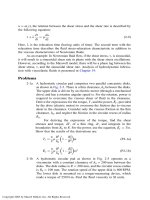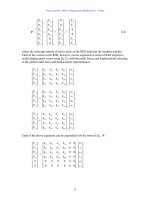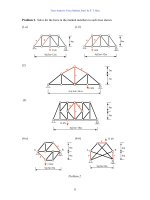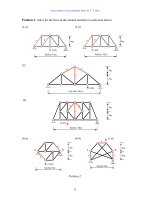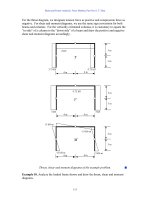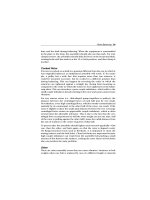(McGraw-Hill) (Instructors Manual) Electric Machinery Fundamentals 4th Edition Episode 1 Part 4 pot
Bạn đang xem bản rút gọn của tài liệu. Xem và tải ngay bản đầy đủ của tài liệu tại đây (641.78 KB, 20 trang )
55
The resulting equivalent circuit referred to the primary at 50 Hz is shown below:
+
-
V
S
V
P
I
S
+
-
I
P
R
C
jX
M
R
EQ
jX
EQ
1.31 MΩ j473 kΩ
260 Ω j917 Ω
2-20. Prove that the three-phase system of voltages on the secondary of the Y-
∆
transformer shown in Figure 2-
38b lags the three-phase system of voltages on the primary of the transformer by 30°.
S
OLUTION
The figure is reproduced below:
V
C
V
B
V
A
V
C
'
V
A
'
V
B
'
++
+
+
+
+
-
-
-
-
+
+
++
+
+
V
A
'
V
B
'
V
C
'
V
A
V
B
V
C
56
Assume that the phase voltages on the primary side are given by
°∠= 0
PA
V
φ
V °−∠= 120
PB
V
φ
V °∠= 120
PC
V
φ
V
Then the phase voltages on the secondary side are given by
°∠=
′
0
SA
V
φ
V
°−∠=
′
120
SB
V
φ
V
°∠=
′
120
SC
V
φ
V
where
aVV
PS
/
φφ
= . Since this is a Y-
∆
transformer bank, the line voltage
ab
V on the primary side is
°∠=°−∠−°∠=−= 3031200
PPPBAab
VVV
φφφ
VVV
and the voltage
°∠=
′
=
′′
0
SAba
V
φ
VV
. Note that the line voltage on the secondary side lags the line
voltage on the primary side by 30
°
.
2-21. Prove that the three-phase system of voltages on the secondary of the
∆
-Y transformer shown in Figure 2-
38c lags the three-phase system of voltages on the primary of the transformer by 30°.
S
OLUTION
The figure is reproduced below:
++
++
V
A
V
A
'
V
B
V
B
'
V
C
V
C
'
Assume that the phase voltages on the primary side are given by
°∠= 0
PA
V
φ
V °−∠= 120
PB
V
φ
V °∠= 120
PC
V
φ
V
57
Then the phase voltages on the secondary side are given by
°∠=
′
0
SA
V
φ
V
°−∠=
′
120
SB
V
φ
V
°∠=
′
120
SC
V
φ
V
where
aVV
PS
/
φφ
=
. Since this is a
∆
-Y transformer bank, the line voltage
ab
V
on the primary side is just
equal to
°∠= 0
PA
V
φ
V
. The line voltage on the secondary side is given by
°−∠=°∠−°∠=−=
′′
3031200
PPPCAba
VVV
φφφ
VVV
Note that the line voltage on the secondary side lags the line voltage on the primary side by 30
°
.
2-22. A single-phase 10-kVA 480/120-V transformer is to be used as an autotransformer tying a 600-V
distribution line to a 480-V load. When it is tested as a conventional transformer, the following values are
measured on the primary (480-V) side of the transformer:
Open-circuit test Short-circuit test
V
OC
= 480 V V
SC
= 10.0 V
I
OC
= 0.41 A I
SC
= 10.6 A
V
OC
= 38 W P
SC
= 26 W
(a) Find the per-unit equivalent circuit of this transformer when it is connected in the conventional manner.
What is the efficiency of the transformer at rated conditions and unity power factor? What is the
voltage regulation at those conditions?
(b) Sketch the transformer connections when it is used as a 600/480-V step-down autotransformer.
(c) What is the kilovoltampere rating of this transformer when it is used in the autotransformer connection?
(d) Answer the questions in (a) for the autotransformer connection.
S
OLUTION
(a) The base impedance of this transformer referred to the primary side is
()
()
2
2
base,
480 V
23.04
10 kVA
P
P
V
Z
S
== =Ω
The open circuit test yields the values for the excitation branch (referred to the primary side):
,
,
0.41 A
0.000854 S
480 V
OC
EX
OC
I
Y
V
φ
φ
== =
()( )
11
38 W
cos cos 78.87
480 V 0.41 A
OC
OC OC
P
VI
θ
−−
=− =− =− °
0.000854 78.87 0.000165 0.000838
EX C M
YGjB j=− = ∠− °= −
1/ 6063
CC
RG==Ω
1/ 1193
MM
XB==Ω
The excitation branch elements can be expressed in per-unit as
6063
263 pu
23.04
C
R
Ω
==
Ω
1193
51.8 pu
23.04
M
X
Ω
==
Ω
The short circuit test yields the values for the series impedances (referred to the primary side):
10.0 V
0.943
10.6 A
SC
EQ
SC
V
Z
I
== = Ω
58
()()
11
26 W
cos cos 75.8
10.0 V 10.6 A
SC
SC SC
P
VI
θ
−−
== =°
0.943 75.8 0.231 0.915
EQ EQ EQ
ZRjX j=+ = ∠°= + Ω
The resulting per-unit impedances are
0.231
0.010 pu
23.04
EQ
R
Ω
==
Ω
0.915
0.0397 pu
23.04
EQ
X
Ω
==
Ω
The per-unit equivalent circuit is
+
-
V
S
V
P
I
S
+
-
I
P
R
C
jX
M
R
EQ
jX
EQ
0.010
j
0.0397
263
j
51.8
At rated conditions and unity power factor, the input power to this transformer would be
IN
P
= 1.0 pu.
The core losses (in resistor
C
R ) would be
(
)
2
2
core
1.0
0.00380 pu
263
C
V
P
R
== =
The copper losses (in resistor
EQ
R ) would be
()( )
2
2
CU EQ
1.0 0.010 0.010 puPIR== =
The output power of the transformer would be
OUT OUT CU core
1.0 0.010 0.0038 0.986PPPP=−−=− − =
and the transformer efficiency would be
OUT
IN
0.986
100% 100% 98.6%
1.0
P
P
η
=× = × =
The output voltage of this transformer is
()( )
OUT IN EQ
1.0 1.0 0 0.01 0.0397 0.991 2.3Zj=− =−∠° + = ∠−°VVI
The voltage regulation of the transformer is
1.0 0.991
VR 100% 0.9%
0.991
−
=×=
(b) The autotransformer connection for 600/480 V stepdown operation is
59
+
-
+
-
480 V
600 V
N
C
N
SE
V
SE
V
C
+
+
-
-
(c) When used as an autotransformer, the kVA rating of this transformer becomes:
()
SE
IO
SE
41
10 kVA 50 kVA
1
C
W
NN
SS
N
++
== =
(d) As an autotransformer, the per-unit series impedance
EQ
Z
is decreased by the reciprocal of the power
advantage, so the series impedance becomes
0.010
0.002 pu
5
EQ
R ==
0.0397
0.00794 pu
5
EQ
X ==
while the magnetization branch elements are basically unchanged. At rated conditions and unity power
factor, the input power to this transformer would be
IN
P
= 1.0 pu. The core losses (in resistor
C
R
) would
be
(
)
2
2
core
1.0
0.00380 pu
263
C
V
P
R
== =
The copper losses (in resistor
EQ
R ) would be
()( )
2
2
CU EQ
1.0 0.002 0.002 puPIR== =
The output power of the transformer would be
OUT OUT CU core
1.0 0.002 0.0038 0.994PPPP=−−=− − =
and the transformer efficiency would be
OUT
IN
0.994
100% 100% 99.4%
1.0
P
P
η
=× = × =
The output voltage of this transformer is
()( )
OUT IN EQ
1.0 1.0 0 0.002 0.00794 0.998 0.5Zj=− =−∠° + = ∠−°VVI
The voltage regulation of the transformer is
1.0 0.998
VR 100% 0.2%
0.998
−
=×=
2-23. Figure P2-4 shows a power system consisting of a three-phase 480-V 60-Hz generator supplying two loads
through a transmission line with a pair of transformers at either end.
(a) Sketch the per-phase equivalent circuit of this power system.
60
(b) With the switch opened, find the real power P, reactive power Q, and apparent power S supplied by the
generator. What is the power factor of the generator?
(c) With the switch closed, find the real power P, reactive power Q, and apparent power S supplied by the
generator. What is the power factor of the generator?
(d) What are the transmission losses (transformer plus transmission line losses) in this system with the
switch open? With the switch closed? What is the effect of adding Load 2 to the system?
Region 1 Region 2 Region 3
base1
S
= 1000 kVA
base2
S
= 1000 kVA
base3
S
= 1000 kVA
base2,L
V = 480 V
base2,L
V = 14,400 V
base3,L
V = 480 V
S
OLUTION
This problem can best be solved using the per-unit system of measurements. The power system
can be divided into three regions by the two transformers. If the per-unit base quantities in Region 1 are
chosen to be
base1
S = 1000 kVA and
base1,L
V = 480 V, then the base quantities in Regions 2 and 3 will be as
shown above. The base impedances of each region will be:
(
)
2
2
1
base1
base1
3
3 277 V
0.238
1000 kVA
V
Z
S
φ
== = Ω
()
2
2
2
base2
base2
3
38314 V
207.4
1000 kVA
V
Z
S
φ
== =Ω
(
)
2
2
3
base3
base3
3
3277 V
0.238
1000 kVA
V
Z
S
φ
== =Ω
(a) To get the per-unit, per-phase equivalent circuit, we must convert each impedance in the system to
per-unit on the base of the region in which it is located. The impedance of transformer
1
T
is already in per-
unit to the proper base, so we don’t have to do anything to it:
010.0
pu,1
=R
040.0
pu,1
=X
The impedance of transformer
2
T is already in per-unit, but it is per-unit to the base of transformer
2
T , so
it must be converted to the base of the power system.
()()
()()
2
base 1 base 2
pu on base 2 pu on base 1
2
base 2 base 1
( , , ) ( , , )
VS
RX Z RX Z
VS
=
(2-60)
()( )
()( )
2
2,pu
2
8314 V 1000 kVA
0.020 0.040
8314 V 500 kVA
R ==
()( )
()( )
2
2,pu
2
8314 V 1000 kVA
0.085 0.170
8314 V 500 kVA
X ==
61
The per-unit impedance of the transmission line is
line
line,pu
base2
1.5 10
0.00723 0.0482
207.4
Zj
Zj
Z
+Ω
== = +
Ω
The per-unit impedance of Load 1 is
load1
load1,pu
base3
0.45 36.87
1.513 1.134
0.238
Z
Zj
Z
∠°Ω
== =+
Ω
The per-unit impedance of Load 2 is
load2
load2,pu
base3
0.8
3.36
0.238
Zj
Zj
Z
−Ω
== =−
Ω
The resulting per-unit, per-phase equivalent circuit is shown below:
+
-
1∠0°
T
1
T
2
Line
L
1
L
2
0.010 j0.040 0.00723 j0.0482 0.040 j0.170
1.513
j1.134
-j3.36
(b) With the switch opened, the equivalent impedance of this circuit is
EQ
0.010 0.040 0.00723 0.0482 0.040 0.170 1.513 1.134Zj j j j=+ + + ++ ++
EQ
1.5702 1.3922 2.099 41.6Zj=+ =∠°
The resulting current is
10
0.4765 41.6
2.099 41.6
∠°
==∠−°
∠°
I
The load voltage under these conditions would be
()()
Load,pu Load
0.4765 41.6 1.513 1.134 0.901 4.7Zj== ∠−°+ =∠−°VI
()( )
Load Load,pu base3
0.901 480 V 432 VVVV== =
The power supplied to the load is
()()
2
2
Load,pu Load
0.4765 1.513 0.344PIR== =
()( )
Load Load,pu base
0.344 1000 kVA 344 kWPPS== =
The power supplied by the generator is
()( )
,pu
cos 1 0.4765 cos41.6 0.356
G
PVI
θ
== °=
()( )
,pu
sin 1 0.4765 sin 41.6 0.316
G
QVI
θ
== °=
()( )
,pu
1 0.4765 0.4765
G
SVI== =
()( )
,pu base
0.356 1000 kVA 356 kW
GG
PPS== =
()( )
,pu base
0.316 1000 kVA 316 kVAR
GG
QQS== =
()( )
,pu base
0.4765 1000 kVA 476.5 kVA
GG
SSS== =
The power factor of the generator is
62
PF cos 41.6 0.748 lagging=°=
(c) With the switch closed, the equivalent impedance of this circuit is
()()
()()
EQ
1.513 1.134 3.36
0.010 0.040 0.00723 0.0482 0.040 0.170
1.513 1.134 3.36
jj
Zj j j
jj
+−
=+ + + ++ +
++−
EQ
0.010 0.040 0.00788 0.0525 0.040 0.170 (2.358 0.109)Zj j j j=+++++++
EQ
2.415 0.367 2.443 8.65Zj=+ =∠°
The resulting current is
10
0.409 8.65
2.443 8.65
∠°
==∠−°
∠°
I
The load voltage under these conditions would be
()()
Load,pu Load
0.409 8.65 2.358 0.109 0.966 6.0Zj==∠−°+ =∠−°VI
()( )
Load Load,pu base3
0.966 480 V 464 VVVV== =
The power supplied to the two loads is the power supplied to the resistive component of the parallel
combination of the two loads: 2.358 pu.
()()
2
2
Load,pu Load
0.409 2.358 0.394PIR== =
()( )
Load Load,pu base
0.394 1000 kVA 394 kWPPS== =
The power supplied by the generator is
()( )
,pu
cos 1 0.409 cos6.0 0.407
G
PVI
θ
== °=
()( )
,pu
sin 1 0.409 sin 6.0 0.0428
G
QVI
θ
== °=
()( )
,pu
1 0.409 0.409
G
SVI== =
()( )
,pu base
0.407 1000 kVA 407 kW
GG
PPS== =
()( )
,pu base
0.0428 1000 kVA 42.8 kVAR
GG
QQS== =
()( )
,pu base
0.409 1000 kVA 409 kVA
GG
SSS== =
The power factor of the generator is
PF cos 6.0 0.995 lagging=°=
(d) The transmission losses with the switch open are:
()( )
2
2
line,pu line
0.4765 0.00723 0.00164PIR== =
()( )
line l ,pu base
0.00164 1000 kVA 1.64 kW
ine
PPS== =
The transmission losses with the switch closed are:
()( )
2
2
line,pu line
0.409 0.00723 0.00121PIR== =
()( )
line l ,pu base
0.00121 1000 kVA 1.21 kW
ine
PPS== =
Load 2 improved the power factor of the system, increasing the load voltage and the total power supplied to
the loads, while simultaneously decreasing the current in the transmission line and the transmission line
losses. This problem is a good example of the advantages of power factor correction in power systems.
63
Chapter 3:
Introduction to Power Electronics
3-1. Calculate the ripple factor of a three-phase half-wave rectifier circuit, both analytically and using
MATLAB.
S
OLUTION
A three-phase half-wave rectifier and its output voltage are shown below
π
/6
5
π
/6
2
π
/3
()
sin
AM
vt V t
ω
=
() ( )
sin 2 /3
BM
vt V t
ωπ
=−
() ( )
sin 2 / 3
CM
vt V t
ωπ
=+
S
OLUTION
If we find the average and rms values over the interval from
π
/6 to 5
π
/6 (one period), these
values will be the same as the average and rms values of the entire waveform, and they can be used to
calculate the ripple factor. The average voltage is
()
5/6
/6
13
() sin
2
DC M
VvtdtVtdt
T
π
π
ωω
π
==
5
6
6
333333
cos 0.8270
22222
MM
DC MM
VV
Vt VV
π
π
ω
ππ π
=− =− − − = =
The rms voltage is
()
5/6
222
rms
/6
13
() sin
2
M
VvtdtVtdt
T
π
π
ωω
π
==
5/6
2
rms
/
6
311
sin 2
22 4
M
V
Vtt
π
π
ωω
π
=−
64
2
rms
315 15
sin sin
22664 3 3
M
V
V
ππ π π
π
=−−−
22
rms
315 3133
sin sin
234 3 3 23422
MM
VV
V
πππ π
ππ
=−−=−−−
22
rms
31333 3
0.8407
23422 234
MM
M
VV
VV
ππ
ππ
=−−−=+=
The resulting ripple factor is
22
rms
DC
0.8407
1 100% 1 100% 18.3%
0.8270
M
M
VV
r
VV
=−×= −×=
The ripple can be calculated with MATLAB using the
ripple
function developed in the text. We must
right a new function
halfwave3
to simulate the output of a three-phase half-wave rectifier. This output
is just the largest voltage of
()
tv
A
,
()
tv
B
, and
()
tv
C
at any particular time. The function is shown below:
function volts = halfwave3(wt)
% Function to simulate the output of a three-phase
% half-wave rectifier.
% wt = Phase in radians (=omega x time)
% Convert input to the range 0 <= wt < 2*pi
while wt >= 2*pi
wt = wt - 2*pi;
end
while wt < 0
wt = wt + 2*pi;
end
% Simulate the output of the rectifier.
a = sin(wt);
b = sin(wt - 2*pi/3);
c = sin(wt + 2*pi/3);
volts = max( [ a b c ] );
The function
ripple
is reproduced below. It is identical to the one in the textbook.
function r = ripple(waveform)
% Function to calculate the ripple on an input waveform.
% Calculate the average value of the waveform
nvals = size(waveform,2);
temp = 0;
for ii = 1:nvals
temp = temp + waveform(ii);
end
average = temp/nvals;
% Calculate rms value of waveform
65
temp = 0;
for ii = 1:nvals
temp = temp + waveform(ii)^2;
end
rms = sqrt(temp/nvals);
% Calculate ripple factor
r = sqrt((rms / average)^2 - 1) * 100;
Finally, the test driver program is shown below.
% M-file:
test_halfwave3.m
% M-file to calculate the ripple on the output of a
% three phase half-wave rectifier.
% First, generate the output of a three-phase half-wave
% rectifier
waveform = zeros(1,128);
for ii = 1:128
waveform(ii) = halfwave3(ii* pi/64);
end
% Now calculate the ripple factor
r = ripple(waveform);
% Print out the result
string = ['The ripple is ' num2str(r) '%.'];
disp(string);
When this program is executed, the results are
»
test_halfwave3
The ripple is 18.2759%.
This answer agrees with the analytical solution above.
3-2. Calculate the ripple factor of a three-phase full-wave rectifier circuit, both analytically and using
MATLAB.
S
OLUTION
A three-phase half-wave rectifier and its output voltage are shown below
66
T
/12
()
sin
AM
vt V t
ω
=
() ( )
sin 2 / 3
BM
vt V t
ωπ
=−
() ( )
sin 2 / 3
CM
vt V t
ωπ
=+
S
OLUTION
By symmetry, the rms voltage over the interval from 0 to T/12 will be the same as the rms
voltage over the whole interval. Over that interval, the output voltage is:
() () ()
22
sin sin
33
CB M M
vt vt vt V t V t
ππ
ωω
=−= +− −
()
22 22
sin cos cos sin sin cos cos sin
33 33
MM
vt V t t V t t
ππ ππ
ωω ωω
=+−−
()
2
2cos sin 3cos
3
M
vt V t t
π
ωω
==
Note that the period of the waveform is
2/T
πω
=
, so T/12 is
/
6
πω
. The average voltage over the
interval from 0 to T/12 is
/6
/
6
0
0
16 63
() 3 cos sin
DC M M
Vvtdt VtdtVt
T
πω
πω
ω
ωω
ππ
== =
33
1.6540
DC M M
VV V
π
==
The rms voltage is
/6
222
rms
0
16
() 3 cos
M
Vvtdt Vtdt
T
πω
ω
ω
π
==
67
/
6
2
rms
0
18 1 1
sin 2
24
M
VVt t
πω
ω
ω
πω
=+
rms
18 1 3 9 3
sin 1.6554
12 4 3 2 4
MMM
VV V V
ωπ π
πωω π
=+=+=
The resulting ripple factor is
2
2
rms
DC
1.6554
1 100% 1 100% 4.2%
1.6540
M
M
VV
r
VV
=−×= −×=
The ripple can be calculated with MATLAB using the
ripple function developed in the text. We must
right a new function
fullwave3
to simulate the output of a three-phase half-wave rectifier. This output
is just the largest voltage of
()
tv
A
,
()
tv
B
, and
()
tv
C
at any particular time. The function is shown below:
function volts = fullwave3(wt)
% Function to simulate the output of a three-phase
% full-wave rectifier.
% wt = Phase in radians (=omega x time)
% Convert input to the range 0 <= wt < 2*pi
while wt >= 2*pi
wt = wt - 2*pi;
end
while wt < 0
wt = wt + 2*pi;
end
% Simulate the output of the rectifier.
a = sin(wt);
b = sin(wt - 2*pi/3);
c = sin(wt + 2*pi/3);
volts = max( [ a b c ] ) - min( [ a b c ] );
The test driver program is shown below.
% M-file: test_fullwave3.m
% M-file to calculate the ripple on the output of a
% three phase full-wave rectifier.
% First, generate the output of a three-phase full-wave
% rectifier
waveform = zeros(1,128);
for ii = 1:128
waveform(ii) = fullwave3(ii*pi/64);
end
% Now calculate the ripple factor
r = ripple(waveform);
% Print out the result
string = ['The ripple is ' num2str(r) '%.'];
disp(string);
68
When this program is executed, the results are
» test_fullwave3
The ripple is 4.2017%.
This answer agrees with the analytical solution above.
3-3. Explain the operation of the circuit shown in Figure P3-1. What would happen in this circuit if switch S
1
were closed?
S
OLUTION
Diode D
1
and D
2
together with the transformer form a full-wave rectifier. Therefore, a voltage
oriented positive-to-negative as shown will be applied to the SCR and the control circuit on each half cycle.
(1) Initially, the SCR is an open circuit, since v
1
< V
BO
for the SCR. Therefore, no current flows to the
load and v
LOAD
= 0.
(2) Voltage v
1
is applied to the control circuit, charging capacitor C
1
with time constant RC
1
.
(3) When v
C
> V
BO
for the DIAC, it conducts, supplying a gate current to the SCR.
(4) The gate current in the SCR lowers its breakover voltage, and the SCR fires. When the SCR fires,
current flows through the SCR and the load.
(5) The current flow continues until i
D
falls below I
H
for the SCR (at the end of the half cycle). The
process starts over in the next half cycle.
69
If switch S
1
is shut, the charging time constant is increased, and the DIAC fires later in each half cycle.
Therefore, less power is supplied to the load.
3-4. What would the rms voltage on the load in the circuit in Figure P3-1 be if the firing angle of the SCR were
(a) 0°, (b) 30°, (c) 90°?
S
OLUTION
The input voltage to the circuit of Figure P3-1 is
()
ttv
ω
sin339
ac
=
, where
rad/s 377=
ω
Therefore, the voltage on the secondary of the transformer will be
()
ttv
ω
sin5.169
ac
=
(a) The average voltage applied to the load will be the integral over the conducting portion of the half
cycle divided by
π
/
ω
, the period of a half cycle. For a firing angle of 0°, the average voltage will be
/
/
ave
0
00
11
() sin cos
T
MM
VvtdtVtdtVt
T
πω
πω
ω
ωω
ππ
== =−
[]
()( )
ave
12
1 1 0.637 169.5 V 108 V
MM
VV V
ππ
=− − − = = =
(b) For a firing angle of 30°, the average voltage will be
/
/
ave
/
6
/6 /6
11
() sin cos
T
MM
VvtdtVtdtVt
T
πω
πω
π
ππ
ω
ωω
ππ
== =−
()( )
ave
1323
1 0.594 169.5 V 101 V
22
MM
VV V
ππ
+
=− − − = = =
(c) For a firing angle of 90°, the average voltage will be
/
/
ave
/
2
/2 /2
11
() sin cos
T
MM
VvtdtVtdtVt
T
πω
πω
π
ππ
ω
ωω
ππ
== =−
70
[]
()( )
ave
11
1 0.318 169.5 V 54 V
MM
VV V
ππ
=− − = = =
3-5. For the circuit in Figure P3-1, assume that
V
BO
for the DIAC is 30 V, C
1
is 1 µF, R is adjustable in the
range 1-20 kΩ, and that switch S
1
is open. What is the firing angle of the circuit when R is 10 kΩ? What
is the rms voltage on the load under these conditions?
Note:
Problem 3-5 is significantly harder for many students, since it involves solving
a differential equation with a forcing function. This problem should only be
assigned if the class has the mathematical sophistication to handle it.
S
OLUTION
At the beginning of each half cycle, the voltages across the DIAC and the SCR will both be
smaller then their respective breakover voltages, so no current will flow to the load (except for the very tiny
current charging capacitor C), and v
load
(t) will be 0 volts. However, capacitor C charges up through
resistor R, and when the voltage v
C
(t) builds up to the breakover voltage of D
1
, the DIAC will start to
conduct. This current flows through the gate of SCR
1
, turning the SCR ON. When it turns ON, the
voltage across the SCR will drop to 0, and the full source voltage v
S
(t) will be applied to the load,
producing a current flow through the load. The SCR continues to conduct until the current through it falls
below I
H
, which happens at the very end of the half cycle.
Note that after D
1
turns on, capacitor C discharges through it and the gate of the SCR. At the end of the
half cycle, the voltage on the capacitor is again essentially 0 volts, and the whole process is ready to start
over again at the beginning of the next half cycle.
To determine when the DIAC and the SCR fire in this circuit, we must determine when v
C
(t) exceeds V
BO
for D
1
. This calculation is much harder than in the examples in the book, because in the previous problems
the source was a simple DC voltage source, while here the voltage source is sinusoidal. However, the
principles are identical.
(a) To determine when the SCR will turn ON, we must calculate the voltage v
C
(t), and then solve for the time
at which v
C
(t) exceeds V
BO
for D
1
. At the beginning of the half cycle, D
1
and SCR
1
are OFF, and the
voltage across the load is essentially 0, so the entire source voltage v
S
(t) is applied to the series RC circuit.
To determine the voltage v
C
(t) on the capacitor, we can write a Kirchhoff's Current Law equation at the
node above the capacitor and solve the resulting equation for v
C
(t).
0
21
=+ ii
(since the DIAC is an open circuit at this time)
0
1
=+
−
C
C
v
dt
d
C
R
vv
71
1
11
v
RC
v
RC
v
dt
d
CC
=+
t
R
C
V
v
R
C
v
dt
d
M
CC
ω
sin
1
=+
The solution can be divided into two parts, a natural response and a forced response. The natural response
is the solution to the differential equation
1
0
CC
d
vv
dt RC
+=
The solution to the natural response differential equation is
()
,
e
t
RC
Cn
vtA
−
=
where the constant A must be determined from the initial conditions in the system. The forced response is
the steady-state solution to the equation
1
sin
M
CC
dV
vv t
dt RC RC
ω
+=
It must have a form similar to the forcing function, so the solution will be of the form
(
)
,1 2
sin cos
Cf
vtB tB t
ωω
=+
where the constants
1
B and
2
B must be determined by substitution into the original equation. Solving for
1
B and
2
B yields:
()()
12 12
1
sin cos sin cos sin
M
dV
BtBt BtBt t
dt RC RC
ωω ωω ω
++ +=
()()
12 12
1
cos in sin cos sin
M
V
BtBst B tB t t
RC RC
ωωω ω ω ω ω
−+ +=
cosine equation:
12
1
0
BB
RC
ω
+=
⇒
21
BRCB
ω
=−
sine equation:
21
1
M
V
BB
RC RC
ω
−+ =
2
11
1
M
V
RC B B
RC RC
ω
+=
2
1
1
M
V
RC B
RC RC
ω
+=
222
1
1
M
RC V
B
RC RC
ω
+
=
Finally,
72
1
222
1
M
V
B
RC
ω
=
+
and
2
222
1
M
RC V
B
RC
ω
ω
−
=
+
Therefore, the forced solution to the equation is
()
,
222 222
sin cos
11
MM
Cf
VRCV
vt t t
RC RC
ω
ωω
ωω
=−
++
and the total solution is
(
)
(
)
(
)
,,CCnCf
vt v t v t=+
()
222 222
sin cos
11
t
MM
RC
C
VRCV
vt Ae t t
RC RC
ω
ωω
ωω
−
=+ −
++
The initial condition for this problem is that the voltage on the capacitor is zero at the beginning of the half-
cycle:
()
0
222 222
0 sin 0 cos 00
11
MM
RC
C
VRCV
vAe
RC RC
ω
ωω
−
=+ − =
++
222
0
1
M
RC V
A
RC
ω
ω
−=
+
222
1
M
RC V
A
RC
ω
ω
=
+
Therefore, the voltage across the capacitor as a function of time before the DIAC fires is
()
222 222 222
sin cos
11 1
t
MM M
RC
C
RC V V RC V
vt e t t
RC RC RC
ωω
ωω
ωω ω
−
=+ −
++ +
If we substitute the known values for R, C,
ω
, and V
M
, this equation becomes
(
)
100
42 11.14 sin 42 cos
t
C
vt e t t
ωω
−
=+ −
This equation is plotted below:
It reaches a voltage of 30 V at a time of 3.50 ms. Since the frequency of the waveform is 60 Hz, the
waveform there are 360
°
in 1/60 s, and the firing angle
α
is
73
()
360
3.50 ms 75.6
1/60 s
α
°
==°
or 1.319 radians
Note: This problem could also have been solved using Laplace Transforms, if desired.
(b) The rms voltage applied to the load is
/
222
rms
1
() sin
M
VvtdtVtdt
T
πω
α
ω
ω
π
==
/
2
rms
11
sin 2
24
M
V
Vtt
πω
α
ωω
π
=−
()()
2
rms
11
sin 2 sin 2
24
M
V
V
πα π α
π
=−−−
rms
0.3284 0.573 97.1 V
MM
VV V===
3-6. One problem with the circuit shown in Figure P3-1 is that it is very sensitive to variations in the input
voltage
vt
ac
(). For example, suppose the peak value of the input voltage were to decrease. Then the time
that it takes capacitor C
1
to charge up to the breakover voltage of the DIAC will increase, and the SCR will
be triggered later in each half cycle. Therefore, the rms voltage supplied to the load will be reduced both by
the lower peak voltage and by the later firing. This same effect happens in the opposite direction if
vt
ac
()
increases. How could this circuit be modified to reduce its sensitivity to variations in input voltage?
S
OLUTION
If the voltage charging the capacitor could be made constant or nearly so, then the feedback
effect would be stopped and the circuit would be less sensitive to voltage variations. A common way to do
this is to use a zener diode that fires at a voltage greater than
BO
V for the DIAC across the RC charging
circuit. This diode holds the voltage across the RC circuit constant, so that the capacitor charging time is
not much affected by changes in the power supply voltage.
v
C
R
74
3-7. Explain the operation of the circuit shown in Figure P3-2, and sketch the output voltage from the circuit.
S
OLUTION
This circuit is a single-phase voltage source inverter.
(1) Initially, suppose that both SCRs are OFF. Then the voltage on the transformer T
3
will be 0, and
voltage V
DC
will be dropped across SCR
1
and SCR
2
as shown.
(2) Now, apply a pulse to transformer T
1
that turns on SCR
1
. When that happens, the circuit looks like:
Since the top of the transformer is now grounded, a voltage V
DC
appears across the upper winding as
shown. This voltage induces a corresponding voltage on the lower half of the winding, charging capacitor
C
1
up to a voltage of 2V
DC
, as shown.
Now, suppose that a pulse is applied to transformer T
2
. When that occurs, SCR
2
becomes a short circuit,
and SCR
1
is turned OFF by the reverse voltage applied to it by capacitor C
1
(forced commutation). At that
time, the circuit looks like:
Now the voltages on the transformer are reversed, charging capacitor C
1
up to a voltage of 2V
DC
in the
opposite direction. When SCR
1
is triggered again, the voltage on C
1
will turn SCR
2
OFF.
The output voltage from this circuit would be roughly a square wave, except that capacitor C
2
filters it
somewhat.

